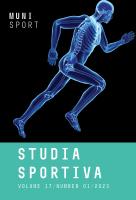Effects of 4-week Olympic weightlifting training on speed and power performance in recreational athletes
Effects of 4-week Olympic weightlifting training on speed and power performance in recreational athletes
Olympic weightlifting effects on speed and power
Author(s): Šime VeršićSubject(s): Social Sciences, Sociology, Sports Studies
Published by: Masarykova univerzita nakladatelství
Keywords: weightlifting; intervention; speed; agility; power
Summary/Abstract: Olympic weightlifting (OW) is sport with high strength and power demands where athletes need to explosively lift heavy weights. It is consisted of barbell lifting snatch and clean and jerk disciplines. In the strength and conditioning training, OW techniques are often used as a method for speed and power development. The aim of this study was to determine effects of 4-week OW training intervention on speed, agility and power performance among young recreational athletes. The sample of participants consisted of 12 Kinesiology students (average 23 years old). They attended the Olympic Weightlifting course. The training intervention lasted 4 weeks and with 3 training sessions per week in which participants practiced OW training based on learning OW techniques and auxiliary lifts execution. Before and after the intervention, measurement was conducted and included power, speed and agility tests. Squat jump (SJ), countermovement jump (CMJ) and drop jump (DJ) were used to estimated lower body power and medicine ball throw (MBT) for upper body power. Sprinting on 5 meters (S5) and 15 meters (S15) were conducted as power and speed tests, while 20 yards test (20Y) measured nonreactive agility performance. All variables were descriptively analysed and T-test for dependent samples was used to determine possible effects of training intervention. Results showed improvement in jumping capacities, with statistically significant difference noted only for CMJ (p>0.01). Upper body power and agility performance did not show any significant changes, while a decline in sprinting performance was found for both S5 (p>0.01) and S15 (p>0.01). While the results in jumping variables are expected and in accordance with current scientific knowledge, the results in sprint tests are somewhat confusing. Possible explanation for this can be found in the fact that the participants worked for four weeks the tasks that biomechanically are not similar to the structure of sprinting movement. This could suggest that athletes who want to improve their explosive speed capacities should include specific sprint stimuli in their training program in addition to OW training program. In the future, more variables and longer treatment duration need to be applied.
Journal: Studia sportiva
- Issue Year: 17/2023
- Issue No: 1
- Page Range: 35-41
- Page Count: 7
- Language: English

